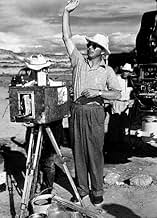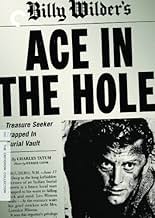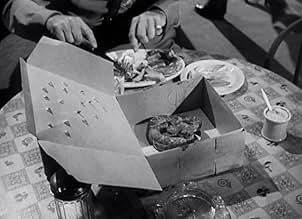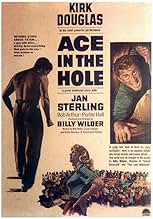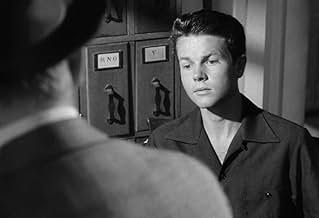Frustrated former journalist Chuck Tatum now working for an Albuquerque newspaper exploits a story about trading post owner Leo Minosa trapped in a cave to rekindle Chuck's career, but the s... Read allFrustrated former journalist Chuck Tatum now working for an Albuquerque newspaper exploits a story about trading post owner Leo Minosa trapped in a cave to rekindle Chuck's career, but the story soon escalates into a media circus.Frustrated former journalist Chuck Tatum now working for an Albuquerque newspaper exploits a story about trading post owner Leo Minosa trapped in a cave to rekindle Chuck's career, but the story soon escalates into a media circus.
- Nominated for 1 Oscar
- 5 wins & 3 nominations total
Robert Arthur
- Herbie Cook
- (as Bob Arthur)
Roy Regnier
- Nagel - New York Editor (replaced by Richard Gaines)
- (scenes deleted)
Oscar Belinda
- Barker
- (uncredited)
Featured reviews
"Ace In the Hole," which used to turn up on local TV as "The Big carnival," was far head of its time. It wasn't very successful and its cynicism shocked people.
Along comes Andy Warhol almost two decades later with his notion of "fifteen minutes of fame" and everyone buys that concept. It's not quite the same as the concept of this. Nor is that of the very popular "Network," which came even later. But the premise here is that reporter Kirk Douglas will literally jeopardize a man's life in order to get a series of big newspaper stories. And does anyone today doubt that such things happen? Wilder was often cynical, though here it is to the most meaningful end. "the Fortune Cookie" and "Kiss Me, Stupid" are cynical also and they are both fun but this one makes a very trenchant point and they do not.
The acting is superb. Kirk Douglas gave many brilliant performances. This is one of them. The trailer included in the DVD I just saw crows that with this Jan Sterling will be immediately elevated to the top rank of female stars. That never happened but she is excellent here, as generally elsewhere.
The interviews of Wilder by Cameron Crowe tell a funny story about the genesis of one of her lines. I'd better not quote it; so get that book. It's very entertaining, informative, and touching.
Wilder was one of =this country's great directors. This will probably never be one of his most popular movies but I'd certainly rank it as one of his best.
Along comes Andy Warhol almost two decades later with his notion of "fifteen minutes of fame" and everyone buys that concept. It's not quite the same as the concept of this. Nor is that of the very popular "Network," which came even later. But the premise here is that reporter Kirk Douglas will literally jeopardize a man's life in order to get a series of big newspaper stories. And does anyone today doubt that such things happen? Wilder was often cynical, though here it is to the most meaningful end. "the Fortune Cookie" and "Kiss Me, Stupid" are cynical also and they are both fun but this one makes a very trenchant point and they do not.
The acting is superb. Kirk Douglas gave many brilliant performances. This is one of them. The trailer included in the DVD I just saw crows that with this Jan Sterling will be immediately elevated to the top rank of female stars. That never happened but she is excellent here, as generally elsewhere.
The interviews of Wilder by Cameron Crowe tell a funny story about the genesis of one of her lines. I'd better not quote it; so get that book. It's very entertaining, informative, and touching.
Wilder was one of =this country's great directors. This will probably never be one of his most popular movies but I'd certainly rank it as one of his best.
10castolon
The movie very closely parallels the real events of January 30 to February 16, 1925 in terms of the general story line. There are some significant differences concerning the actions of the characters.
Floyd Collins, a cave explorer working alone (not a real good idea), was trapped in Sand Cave KY, near Mammoth Cave. He was not looking for treasure, but for a new cave suitable for commercializing to produce income in an economically depressed region...and this was before the Depression occurred.
He became trapped on the way out of the cave by a 27 lb. rock which rolled onto his leg in a narrow crawlway. The configuration was such that it could not be moved enough to get his foot past.
When he failed to return home, the family went searching and quickly found him only 150' inside the cave.
A huge rescue effort was mounted and a cub reporter, Skeets Miller, from Louisville KY showed up to cover the story. It became one of the three most widely broadcast events of the time. Besides the extensive newspaper coverage, the relatively new medium of commercial radio riveted listeners with hourly accounts. It quickly became the first media circus ever seen.
Because of the print and radio coverage people began flocking to the site. A carnival atmosphere did indeed spring up around the cave. The state police and National Guard were called out by the governor to control the chaos and the more than 20,000 onlookers. The similarity between the real event and the movie on this account are likely nearly identical.
As in the movie, a decision was made to drill a shaft and, also as in the movie, the rock was fairly unstable and prone to collapse from the pounding of the cable tool drilling rig. The longer the effort went on, the more unstable the cave passage became.
Unlike Kirk Douglas' character in the movie, Skeets Miller served a most honorable role. Due to his small build he became one of very few persons able, and eventually the only one willing, to enter in an attempt to deliver food and water to Collins. He received a Pulitzer Prize for his reporting. Also unlike the movie, there was no manipulation of the event to delay the rescue, but there was considerable disagreement over how to best do it. Area coal miners made the initial attempts and the event concluded with the above-mentioned shaft.
Collins was presumed to have died 3 days before rescuers reached him. Because the conditions were so unstable, the body was left in the cave. The family was able to remove him about 80 days afterward for a proper burial. Later, his glass-topped casket was returned to the now-commercial cave as a tourist attraction. It was removed once again, and finally, in 1989.
In 1982, a definitive account of the event was published in the book 'Trapped!'. A most informative read.
In a take-off of the 'Free Tibet' bumper stickers, vehicles are occasionally seen with a 'Free Floyd Collins' sticker.
Floyd Collins, a cave explorer working alone (not a real good idea), was trapped in Sand Cave KY, near Mammoth Cave. He was not looking for treasure, but for a new cave suitable for commercializing to produce income in an economically depressed region...and this was before the Depression occurred.
He became trapped on the way out of the cave by a 27 lb. rock which rolled onto his leg in a narrow crawlway. The configuration was such that it could not be moved enough to get his foot past.
When he failed to return home, the family went searching and quickly found him only 150' inside the cave.
A huge rescue effort was mounted and a cub reporter, Skeets Miller, from Louisville KY showed up to cover the story. It became one of the three most widely broadcast events of the time. Besides the extensive newspaper coverage, the relatively new medium of commercial radio riveted listeners with hourly accounts. It quickly became the first media circus ever seen.
Because of the print and radio coverage people began flocking to the site. A carnival atmosphere did indeed spring up around the cave. The state police and National Guard were called out by the governor to control the chaos and the more than 20,000 onlookers. The similarity between the real event and the movie on this account are likely nearly identical.
As in the movie, a decision was made to drill a shaft and, also as in the movie, the rock was fairly unstable and prone to collapse from the pounding of the cable tool drilling rig. The longer the effort went on, the more unstable the cave passage became.
Unlike Kirk Douglas' character in the movie, Skeets Miller served a most honorable role. Due to his small build he became one of very few persons able, and eventually the only one willing, to enter in an attempt to deliver food and water to Collins. He received a Pulitzer Prize for his reporting. Also unlike the movie, there was no manipulation of the event to delay the rescue, but there was considerable disagreement over how to best do it. Area coal miners made the initial attempts and the event concluded with the above-mentioned shaft.
Collins was presumed to have died 3 days before rescuers reached him. Because the conditions were so unstable, the body was left in the cave. The family was able to remove him about 80 days afterward for a proper burial. Later, his glass-topped casket was returned to the now-commercial cave as a tourist attraction. It was removed once again, and finally, in 1989.
In 1982, a definitive account of the event was published in the book 'Trapped!'. A most informative read.
In a take-off of the 'Free Tibet' bumper stickers, vehicles are occasionally seen with a 'Free Floyd Collins' sticker.
There are some films that when you see them you ask why they aren't available to rent or own. This is one of them. I had the fortune of seeing this hidden gem on the big screen and was pleasantly surprised.
With Kirk Douglas playing a Reporter whose been around the block, always looking for a shortcut, comes across an opportunity to exploit a man caught in a mine shaft. I have read where critics had considered the circus atmosphere of the the film unrealistic. It seems Mr. Wilder got the last laugh. If you are interesting in great dialogue and good story telling, I suggest you find this
With Kirk Douglas playing a Reporter whose been around the block, always looking for a shortcut, comes across an opportunity to exploit a man caught in a mine shaft. I have read where critics had considered the circus atmosphere of the the film unrealistic. It seems Mr. Wilder got the last laugh. If you are interesting in great dialogue and good story telling, I suggest you find this
The cynical, unethical and unscrupulous journalist Charles 'Chuck' Tatum (Kirk Douglas) arrives in a small New Mexico newspaper asking for a chance. He was fired from famous newspapers because of drinking problem, lying and even for having an affair with the wife of one of his bosses. His real intention is to use the small newspaper as a "swimming board" to a bigger one. After one year without a bang news and totally bored, Chuck travels with a younger reporter to make the coverage of a matter about rattlesnakes. When they arrive in an isolated gas station, he is informed that a man called Leo Minosa (Richard Benedict) is trapped alive in an old Indian mine in a nearby place called Mountain of the Seven Vultures. Chuck manipulates the local corrupt sheriff, the engineer responsible for the rescue operation and Leo's wife Lorraine Minosa (Jan Sterling), and a rescue that could be made using a simple and common process in twelve hours, lasts six days using a sophisticated drilling system and creating a circus in the previously desert place. Everybody profits with the accident except the victim.
Movies about manipulation of people are usually excellent. I remember Costa-Gravas' "Mad City (1997), Barry Levinson's "Wag the Dog (1997)", Howard Hawks' "His Girl Friday (1940)", and even the recent real case of the chemical weapons. Yesterday I saw "Ace in the Hole" for the first time and I really was impressed how this film is amazingly real and updated. There are elements present in every modern society, such as: the powerful sheriff very corrupt, like most of the worldwide members of the governments; the press, interested in selling news only; the victim used for other interests greater than rescuing him; and the people, completely manipulated and with very short memory. Kirk Douglas is amazing in the role of a nasty reporter. I do not understand why this movie is not in the IMDb Top 250. My vote is ten.
Title (Brazil): "A Montanha dos Sete Abutres" ("The Mountain of the Seven Vultures")
Movies about manipulation of people are usually excellent. I remember Costa-Gravas' "Mad City (1997), Barry Levinson's "Wag the Dog (1997)", Howard Hawks' "His Girl Friday (1940)", and even the recent real case of the chemical weapons. Yesterday I saw "Ace in the Hole" for the first time and I really was impressed how this film is amazingly real and updated. There are elements present in every modern society, such as: the powerful sheriff very corrupt, like most of the worldwide members of the governments; the press, interested in selling news only; the victim used for other interests greater than rescuing him; and the people, completely manipulated and with very short memory. Kirk Douglas is amazing in the role of a nasty reporter. I do not understand why this movie is not in the IMDb Top 250. My vote is ten.
Title (Brazil): "A Montanha dos Sete Abutres" ("The Mountain of the Seven Vultures")
This is a movie I have loved since the first time I saw it as a child. Kirk Douglas plays the lead role in "The Big Carnival", or "Ace in the Hole" as it was originally titled. As down and out former ace newspaper reporter Chuck Tatum, he finds himself broke in the southwest and manages to talk himself into a reporting job with a small town newspaper. He and a cub photographer are sent to cover a snake hunt and on the way they come across a more interesting story. A man hunting Navaho artifacts got caught in a cave in.
Tatum, after visiting the man, Leo Minoso in the cave, has visions of Floyd Collins and a Pulitzer prize dancing in his head. Through blackmail and manipulation of the story, Tatum sells his soul and his journalistic ethics in his quest for a chance at the big time again.
This movie was ahead of it's time in estimating how low the media would go to sell a story. Tatum leads the carnival of onlookers, vendors and other reporters wanting a piece of the story until the inevitable tragic ending occurs. He realizes too late how he has turned a simple event into a tragedy and become part of the story instead of a reporter. Kirk Douglas turns in a powerful performance.
Tatum, after visiting the man, Leo Minoso in the cave, has visions of Floyd Collins and a Pulitzer prize dancing in his head. Through blackmail and manipulation of the story, Tatum sells his soul and his journalistic ethics in his quest for a chance at the big time again.
This movie was ahead of it's time in estimating how low the media would go to sell a story. Tatum leads the carnival of onlookers, vendors and other reporters wanting a piece of the story until the inevitable tragic ending occurs. He realizes too late how he has turned a simple event into a tragedy and become part of the story instead of a reporter. Kirk Douglas turns in a powerful performance.
Did you know
- TriviaAfter the film was released, it got bad reviews and lost money. The studio, without Billy Wilder's permission, changed the title to "The Big Carnival" to increase the box office take of the film. It didn't work. On top of that, Wilder's next picture, Stalag 17 (1953), was a hit and he expected a share of the picture's profits. Paramount's accountants told him that since this picture lost money, the money it lost would be subtracted from the profits of "Stalag 17".
- GoofsWhen Lorraine and Chuck are talking out in front of Minosa's store by the gas pumps, reflections of the crew moving around behind the camera can be seen in the store windows.
- Quotes
Charles Tatum: Bad news sells best. Cause good news is no news.
- ConnectionsFeatured in AFI Life Achievement Award: A Tribute to Billy Wilder (1986)
- SoundtracksThe Hut-Sut Song
(uncredited)
Written by Leo Killion, Ted McMichael and Jack Owens
Sung by Richard Benedict and Kirk Douglas
Details
- Release date
- Country of origin
- Languages
- Also known as
- Cadenas de roca
- Filming locations
- Laguna Pueblo, New Mexico, USA(church exteriors)
- Production company
- See more company credits at IMDbPro
Box office
- Budget
- $1,800,000 (estimated)
- Gross worldwide
- $2,300,087
- Runtime
- 1h 51m(111 min)
- Color
- Aspect ratio
- 1.37 : 1
Contribute to this page
Suggest an edit or add missing content


